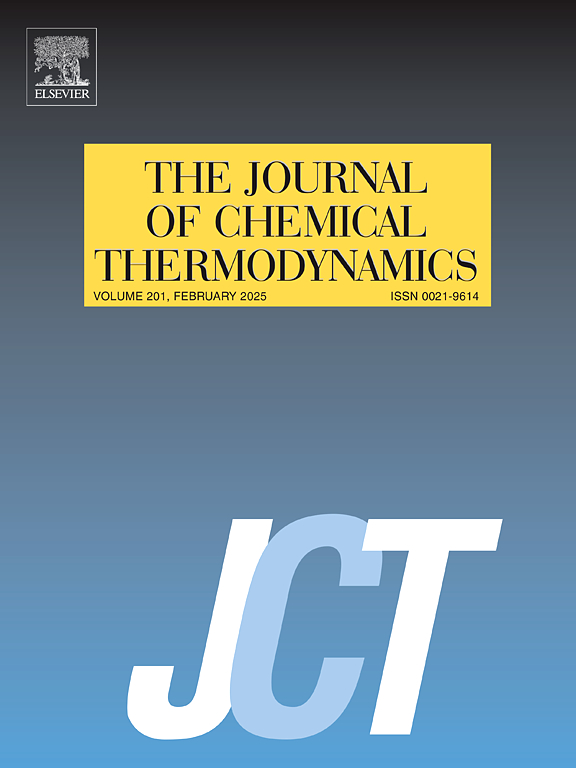Ethylene glycol methyl ether and 1,2-Propylenediamine deep eutectic solvents for CO2 sequestration: Physicochemical properties and intermolecular interactions
IF 2.2
3区 工程技术
Q3 CHEMISTRY, PHYSICAL
引用次数: 0
Abstract
This work introduces the deep eutectic solvents (DESs) composed of ethylene glycol monomethyl ether (EGME) and 1,2-propylenediamine (1,2-PDA) for enhanced CO2 sequestration. Initially, physicochemical properties, encompassing solution density and viscosity, are systemically investigated, while concurrently delving into the intermolecular forces that govern these properties. The DESs demonstrate significantly improved CO2 absorption, overcoming the limitations of traditional amine-based solvents. A detailed analysis reveals that an optimal molar ratio of DESs maximize CO2 absorption, outperforming the individual components. Spectroscopic and quantum chemical calculations were employed to elucidate the mechanisms, which showed that -OH···N (H2) hydrogen bonding plays a critical role in enhancing the efficiency of solvent absorption. The results indicate that at a 65 % EGME molar fraction, the system achieves the most stable physicochemical properties and strongest hydrogen bonding. Notably, DESs with 85 % EGME can achieve an optimal capture performance of up to 1.14 mol CO2/mol 1,2-PDA, nearly doubling 1,2-PDA's adsorption capacity.
用于CO2封存的乙二醇甲基醚和1,2-丙二胺深共晶溶剂:物理化学性质和分子间相互作用
本文介绍了由乙二醇单甲醚(EGME)和1,2-丙二胺(1,2- pda)组成的深度共晶溶剂(DESs),用于增强CO2的固载。首先,系统地研究了包括溶液密度和粘度在内的物理化学性质,同时深入研究了控制这些性质的分子间作用力。DESs的CO2吸收量显著提高,克服了传统胺基溶剂的局限性。详细的分析表明,最佳的DESs摩尔比最大化CO2吸收,优于单个组分。利用光谱和量子化学方法对其机理进行了分析,结果表明-OH···N (H2)氢键对提高溶剂吸收效率起着关键作用。结果表明,当EGME摩尔分数为65%时,体系的物理化学性质最稳定,氢键最强。值得注意的是,含有85% EGME的DESs可以达到1.14 mol CO2/mol 1,2- pda的最佳捕获性能,几乎是1,2- pda吸附量的两倍。
本文章由计算机程序翻译,如有差异,请以英文原文为准。
求助全文
约1分钟内获得全文
求助全文
来源期刊

Journal of Chemical Thermodynamics
工程技术-热力学
CiteScore
5.60
自引率
15.40%
发文量
199
审稿时长
79 days
期刊介绍:
The Journal of Chemical Thermodynamics exists primarily for dissemination of significant new knowledge in experimental equilibrium thermodynamics and transport properties of chemical systems. The defining attributes of The Journal are the quality and relevance of the papers published.
The Journal publishes work relating to gases, liquids, solids, polymers, mixtures, solutions and interfaces. Studies on systems with variability, such as biological or bio-based materials, gas hydrates, among others, will also be considered provided these are well characterized and reproducible where possible. Experimental methods should be described in sufficient detail to allow critical assessment of the accuracy claimed.
Authors are encouraged to provide physical or chemical interpretations of the results. Articles can contain modelling sections providing representations of data or molecular insights into the properties or transformations studied. Theoretical papers on chemical thermodynamics using molecular theory or modelling are also considered.
The Journal welcomes review articles in the field of chemical thermodynamics but prospective authors should first consult one of the Editors concerning the suitability of the proposed review.
Contributions of a routine nature or reporting on uncharacterised materials are not accepted.
 求助内容:
求助内容: 应助结果提醒方式:
应助结果提醒方式:


